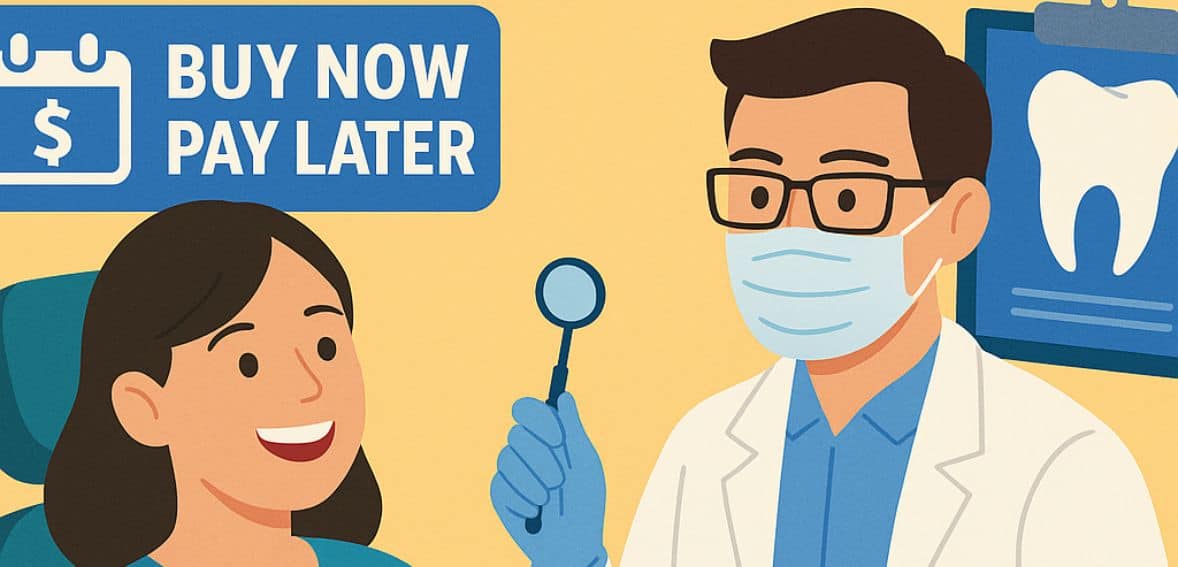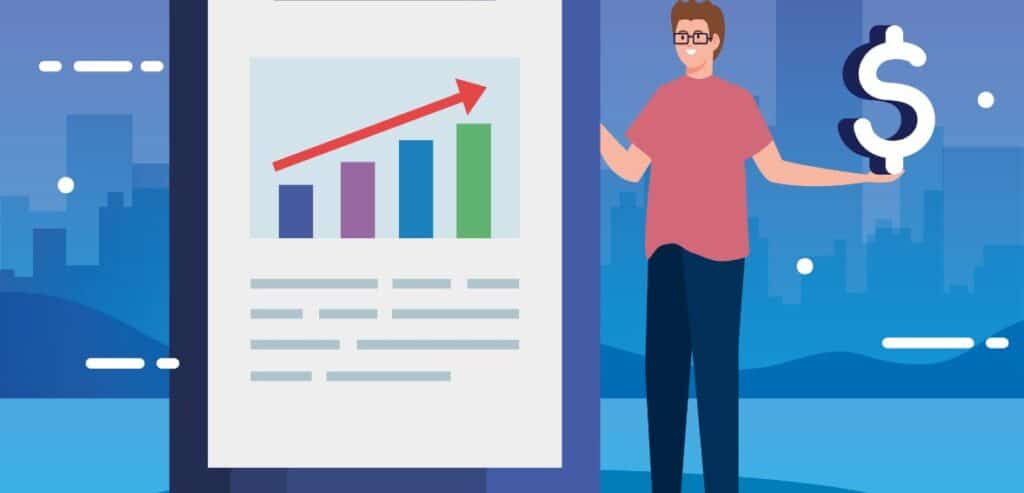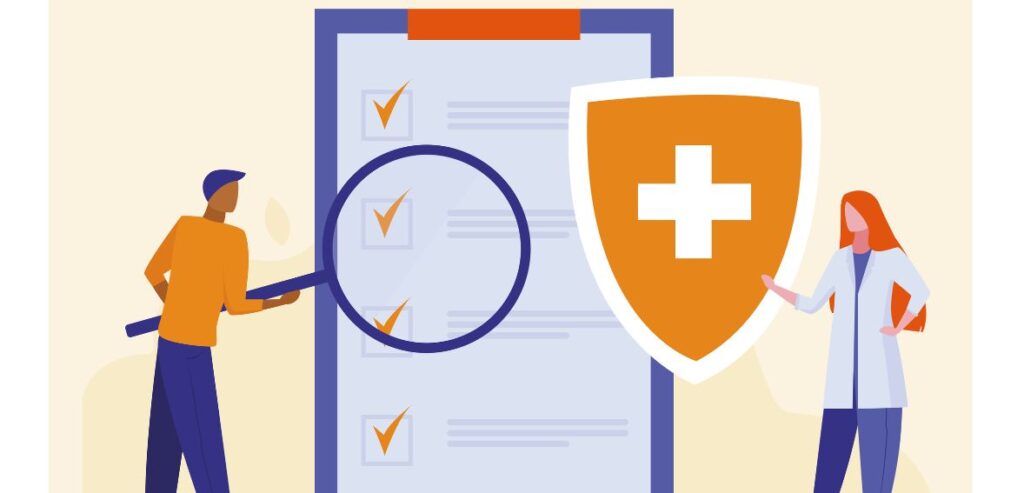
By Francesca Law July 29, 2025
Financial strain is a major reason many patients delay or skip dental treatments. Even with insurance, out-of-pocket expenses can be shocking, particularly for frequently uninsured procedures like crowns, root canals, and cosmetic procedures. A potent instrument to close that gap is Buy Now, Pay Later (BNPL), which enables dental offices to provide compassionate care while maintaining a healthy cash flow.
When implemented thoughtfully, BNPL can help patients prioritize on their oral health and free up practices to provide care without worrying about receiving payment up front. We’ll look at how BNPL functions in dental settings, why it’s becoming more popular, the moral dilemmas it poses, and how to successfully apply it in your office in this article.
How BNPL Works for Dental Practices

In dental settings, BNPL allows patients to receive care without having to pay the entire amount upfront. The financing company approves the majority of applicants immediately after conducting a soft credit check, which rarely affects credit scores. Within one to three business days of a patient’s approval, the provider pays the dentist in full. After that, the patient pays back the BNPL provider over a specified period of time, which could be anything from longer periods with interest to six months of interest-free financing.
Providers like Sunbit offer BNPL products that are specially made for dental offices and range in cost from $60 to $10,000. Depending on the patient’s credit profile, these platforms usually approve 80–85% of applicants and offer repayment terms ranging from 6 to 24 months, with shorter interest-free plans available.
Patient Benefits: Affordability Without Delay
For many patients, especially those without full insurance, dental procedures can be costly, costing hundreds or even thousands of dollars. By distributing that expense over a number of months, BNPL significantly lessens the psychological toll that a sizable upfront payment takes.
Treatment acceptance has increased for practices that offer BNPL, especially for elective procedures or treatments that would otherwise be postponed. The ability to start treatment right away and manage their finances with fixed payments is something that patients value. Industry reports indicate that practices have seen a double-digit increase in treatment acceptance and a notable increase in revenue.
Practice Benefits: Cash Flow and Growth

From a practical standpoint, BNPL provides instant payment with no overhead. Even for more extensive treatments, the provider funds the entire amount within days of the patient’s approval. This removes the administrative strain of managing collections, following up on payments, and monitoring installment plans.
This instant liquidity can help clinics that operate on expensive fees and narrow margins reinvest in expansion, staffing, and equipment. Incorporating dental payment solutions can further optimize cash flow and improve financial stability for practices. Practices that collaborate with BNPL providers also benefit from a competitive edge; clinics can serve populations that previously put off care because of cost, and patient retention increases when flexible payment options are offered.
Technology and Workflow Integration
In a dental office, BNPL implementation is often seamless. As practices increasingly adopt future dental payments like contactless and mobile solutions, integrating financing tools such as BNPL becomes even smoother within modern digital workflows. Digital application flows supported by reputable providers require little data entry and take less than 30 seconds.
For example, Sunbit provides a user-friendly interface that can be used independently or in conjunction with your practice management system. Patients can apply in person or through links in email invoices. Documentation is digital, approval is quick, and no extra hardware or training is needed for the payment process. Without interfering with workflow or patient experience, this integration enables your staff to organically present financing options during treatment planning.
Ethical Considerations and Patient Protections

BNPL raises issues even though it offers convenience and accessibility. Critics fear that because of the ease of use and the lack of extensive credit checks, patients may end up with debt that exceeds their means. Even when promoted as “zero interest,” BNPL can feel like a hidden expense if not adequately explained. Transparent and unambiguous terms must be provided to patients. Patients should be fully informed if there are late payment fees or if the financing terms include interest.
The U.S. Consumer Financial Protection Bureau’s classification of BNPL firms under credit regulations is one example of how dental practices should make sure BNPL providers adhere to new regulations. Additionally, providers should refrain from using marketing financing to pay for pointless procedures.
When BNPL Fits: Ideal Use Cases in Dentistry
In dental offices, Buy Now, Pay Later (BNPL) services are quickly becoming popular, particularly when treatment costs are in the middle range, usually between $300 and $3,000. Procedures that are frequently required but not always fully covered by insurance, such as fillings, crowns, root canals, bridges, and implants, are included in this price range.
When BNPL is offered during the treatment planning stage as opposed to at the last checkout, it is especially successful in boosting case acceptance. To give patients time to process the financial information and make decisions without feeling rushed, successful practices frequently introduce BNPL while talking about care options rather than as a last-minute upsell.
For many patients, the ability to split payments into smaller, interest-free installments removes the financial hesitation that might otherwise delay or derail treatment. This flexibility builds trust and helps patients commit to care they might have otherwise postponed or declined.
Training Staff: Communicating With Care
The way—and the moment—you bring up financing can shape a patient’s entire experience. Your team’s strategy should therefore feel organic rather than predetermined. Trained personnel, particularly treatment coordinators and front desk team members, should approach the discussion in a relaxed, consultative manner rather than yelling off payment plans like a salesperson.
Team members should be ready to explain BNPL in plain, reassuring terms—always steering the focus back to what matters most: getting the care the patient needs without delay or stress.
Regulatory Landscape and Compliance
In the United States, the CFPB started bringing BNPL providers under the same regulatory purview as credit card issuers in 2024. This included requiring dispute resolution procedures and regular billing statements that resembled those of traditional credit. Now, providers like Affirm must follow the same rules as credit card companies—like offering clear billing and dispute resolution.
Practices should select BNPL partners who can support fair consumer practices and dispute resolution while adhering to these standards. Policies pertaining to interest caps and late fees, disclosure formats, and consent procedures ought to be easily understandable and well-documented.
Balancing Patient Needs and Practice Stability

BNPL has clear benefits, but it’s not a one-size-fits-all answer. Dental offices should keep an eye on performance indicators such as frequency of follow-up visits, AR aging, treatment acceptance rates, and patient satisfaction surveys. It can become a vital component of your payment model if BNPL adoption is robust and patients feel at ease.
Alternatives like promotional financing or limited-interest installment loans should be taken into consideration if uptake is poor or misunderstandings occur. Transparency, adaptability, and mutual gain should be given top priority when designing financial tools to fit patient preferences and clinic realities.
Expanding Access in Underserved Communities
Reaching underserved or marginalized communities is one of the most promising uses of BNPL in dental care. Access to reasonably priced dental care is scarce in rural and low-income areas of the United States. In many low-income and rural areas, dental insurance is rare—or doesn’t go far enough. That leaves patients choosing between groceries and dental work.
Due to high interest rates or credit scores that prevent them from obtaining loans or credit cards, traditional financing is usually unaffordable. A bridge to care that would otherwise be delayed or abandoned is provided by BNPL models, particularly those with high approval rates and zero-interest terms. By offering BNPL, these clinics become lifelines—helping patients access care they’d otherwise delay or avoid entirely.
Partnering with providers that don’t penalize patients for lack of prime credit expands inclusivity. As a result, practices become community leaders while also strengthening their business model by bringing in patients who were once financially sidelined. In the long run, this commitment to inclusion doesn’t just improve oral health outcomes—it builds generational loyalty to your practice.
Growing with Confidence: Long-Term Impacts
As dental practices digitally evolve—adding teledentistry, membership models, or subscription-based hygiene plans—BNPL can integrate effectively, providing consistent revenue without collateral burden. Multi-location practices can standardize financing while maintaining branding and messaging consistency across sites. As your patient base grows, a well-implemented BNPL solution simplifies financial workflows without adding friction—especially helpful for dental groups onboarding new locations or service lines.
Conclusion: Financing with Compassion and Strategy
Making high-quality treatment accessible, lowering financial anxiety, and cultivating enduring loyalty are the goals of BNPL implementation for dental care, not just increasing case acceptance or income. Clinics can confidently provide care and receive payment on time when providers like Sunbit and Affirm offer high approval rates, quick application processes, and predictable funding.
Adopting BNPL, however, is still a strategic choice that must be in line with patient objectives, operational procedures, ethical standards, and compliance requirements. When implemented with clear terms, thoughtful consent, and reliable support, BNPL becomes more than just a payment option. It turns into a sympathetic link between clinical quality and affordability.